
 i_need_contribute
i_need_contribute
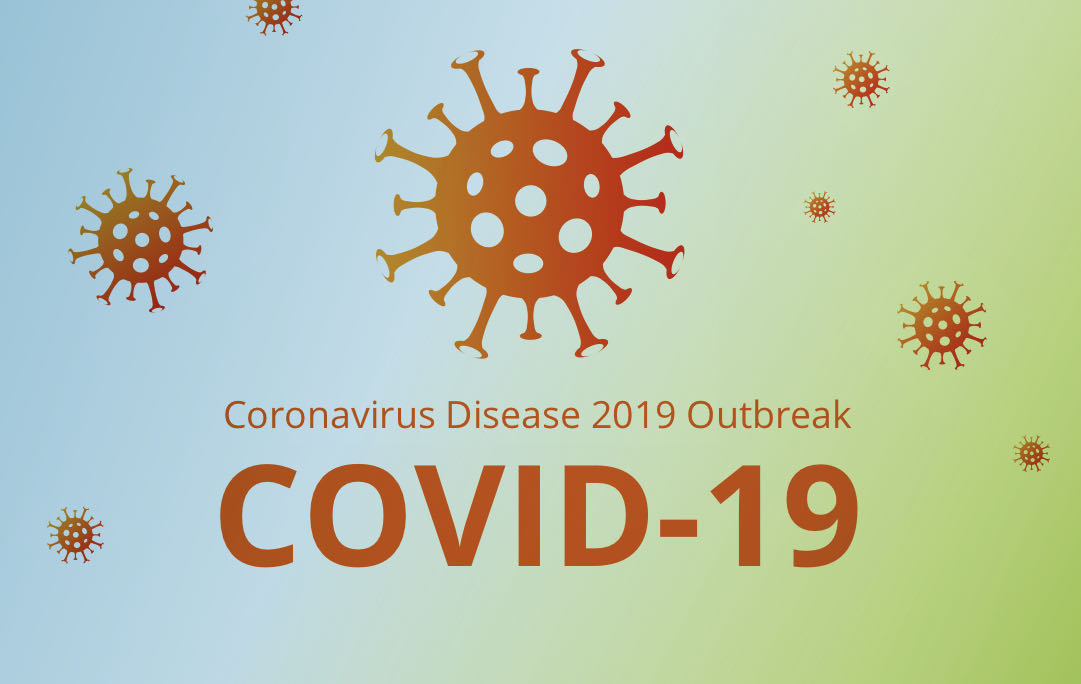
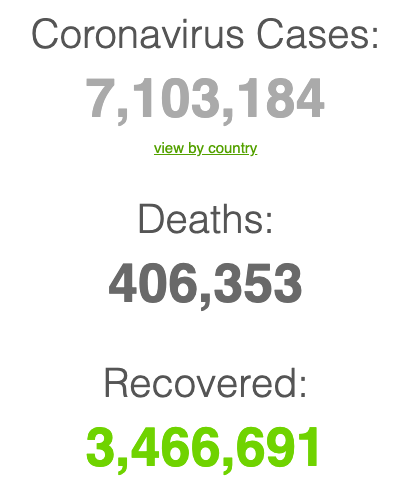

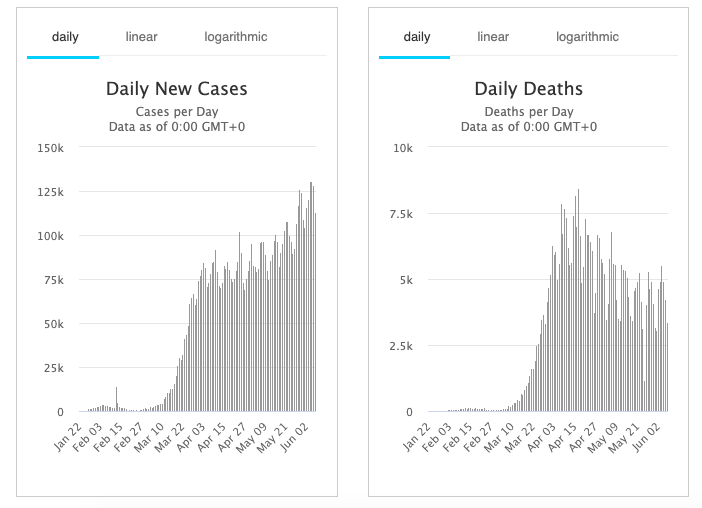
|
Country, |
Total |
New |
Total |
|
World |
7,082,196 |
+113,117 |
405,081 |
|
2,007,449 |
+18,905 |
112,469 |
|
|
691,962 |
+18,375 |
36,499 |
|
|
467,673 |
+8,984 |
5,859 |
|
|
288,630 |
+240 |
27,136 |
|
|
286,194 |
+1,326 |
40,542 |
|
|
257,486 |
+10,864 |
7,207 |
|
|
234,998 |
+197 |
33,899 |
|
|
196,515 |
+4,757 |
5,465 |
|
|
185,869 |
+173 |
8,776 |
|
|
171,789 |
+2,364 |
8,281 |
|
|
170,132 |
+914 |
4,692 |
|
|
153,977 |
+343 |
29,155 |
|
|
134,150 |
+6,405 |
2,190 |
|
|
113,619 |
+3,593 |
13,511 |
|
|
101,914 |
+3,045 |
712 |
|
|
98,943 |
+4,960 |
2,002 |
|
|
95,699 |
+642 |
7,800 |
|
|
83,036 |
+6 |
4,634 |
|
|
68,790 |
+1,595 |
54 |
|
|
65,769 |
+2,743 |
888 |
|
|
59,226 |
+154 |
9,595 |
|
|
48,630 |
+879 |
269 |
|
|
48,285 |
+2,312 |
998 |
|
|
47,574 |
+239 |
6,013 |
|
|
44,730 |
+81 |
4,659 |
|
|
43,120 |
+392 |
3,621 |
|
|
39,236 |
+1,209 |
1,259 |
|
|
38,808 |
+540 |
276 |
|
|
37,910 |
+383 |
25 |
|
|
34,693 |
+342 |
1,479 |
|
|
34,079 |
+1,467 |
1,237 |
|
|
31,848 |
+717 |
264 |
|
|
31,186 |
+672 |
1,851 |
|
|
30,965 |
+9 |
1,921 |
|
|
26,999 |
+485 |
788 |
|
|
26,561 |
+575 |
1,157 |
|
|
25,201 |
+18 |
1,679 |
|
|
22,794 |
+774 |
664 |
|
|
21,895 |
+555 |
1,003 |
|
|
20,479 |
+189 |
1,333 |
|
|
20,342 |
+791 |
357 |
|
|
19,600 |
+405 |
538 |
|
|
17,863 |
+111 |
298 |
|
|
17,141 |
+38 |
916 |
|
|
16,902 |
+4 |
672 |
|
|
16,882 |
+866 |
75 |
|
|
16,425 |
+421 |
393 |
|
|
14,763 |
+380 |
26 |
|
|
13,358 |
+630 |
454 |
|
|
13,130 |
+766 |
200 |
|
|
12,694 |
+183 |
53 |
|
|
12,486 |
+253 |
354 |
|
|
12,366 |
+1,268 |
346 |
|
|
11,948 |
+24 |
589 |
|
|
11,823 |
+82 |
249 |
|
|
11,776 |
+57 |
273 |
|
|
10,154 |
+104 |
707 |
|
|
9,700 |
+189 |
341 |
|
|
9,638 |
+176 |
44 |
|
|
9,628 |
+61 |
327 |
Source: https://www.worldometers.info/coronavirus/

Social distancing markers at an airport in Christchurch, New Zealand, last month.Credit...Mark Baker/Associated Press
Crowds will gather again in New Zealand’s restaurants. Weddings will include as many hugs and guests as the happy couple wants — and even social distancing will not be needed.
New Zealand has no active coronavirus cases and no new cases, officials announced Monday, declaring that life could now return to a form of pre-pandemic normal.
“While the job is not done, there is no denying this is a milestone,” said Prime Minister Jacinda Ardern, adding: “Thank you New Zealand.”
The country of five million people is one of only a few nations that appear to have eradicated the virus, at least for now. Iceland is another.
Ms. Ardern, who led an approach she described as “go hard go early” — with a severe lockdown that began in late March — said the country could now focus without distraction on economic recovery and boosting local businesses.
“Retail is back without limitation,” she said. “Hospitality is back without limitation; public transport and travel across the country is fully open.”
The return to freedom of movement, however, is not quite complete. With the pandemic continuing to rage elsewhere, the country’s borders are still locked down. Plans for a travel bubble with Australia are in the works, but moving slowly.
Ms. Ardern also announced that QR codes would be appearing wherever people gather. She asked businesses to remind people to scan the codes into the government’s contact tracing app to make any future outbreak easier to track and isolate.
“This is a key new habit we’re asking all New Zealanders to adopt,” she said, adding that it was a lingering bit of extra effort made possible by all the work that had already been completed.
“The virus will be in our world for some time to come,” she said. “We are confident we have eliminated transmission of the virus for now, but elimination is not a point in time; it is a sustained effort.”

Coronavirus diagnostic testing supplies that the United States Agency for International Development gave Honduras in April. Credit...Orlando Sierra/Agence France-Presse — Getty Images
Months before an election in which some farm states are major battlegrounds, Democrats and other critics of the administration’s agriculture policies are concerned that new agriculture subsidies, provided by Congress with bipartisan backing, could be doled out to ensure President Trump continues to enjoy the backing of one of his key voting blocs.
The Trump administration’s $28 billion effort in 2018 and 2019 to compensate farmers for losses from its trade wars has been criticized as excessive, devised on the fly and tilted toward states politically important to Republicans, writes Sharon LaFraniere of The Times.
Now the administration is starting to send farmers tens of billions more to offset losses from the coronavirus pandemic, raising questions about how the money will be allocated and whether there is sufficient oversight to guard against partisan abuse of the program.
The Trump administration has lauded itself as leading the world in confronting the coronavirus. But it has so far failed to spend more than 75 percent of the American humanitarian aid that Congress provided three months ago to help overseas victims of the virus.
In two spending bills in March, lawmakers approved $1.59 billion in pandemic assistance to be sent abroad through the State Department and the United States Agency for International Development.
As of last week, $386 million had been released to nations in need, according to a government official familiar with the spending totals that the State Department has reported to Congress for both agencies.
As protests over police brutality roil cities, this is an extraordinary moment of pain, especially for black Americans who are bearing the brunt of three crises — police violence, crushing unemployment and the deadliest infectious disease threat in a century. Public health experts, activists and lawmakers say the triple threat requires a coordinated response.
“These are interrelated crises — the crisis of racism and inequality that is now converging with the crisis of Covid-19,” said Dr. Leana S. Wen, the former health commissioner of Baltimore who testified before Congress about racial disparities in the pandemic.
The precise toll that the coronavirus has taken on people of color remains unknown; not every state collects data, writes Sheryl Gay Stolberg. An analysis of data from 40 states and the District of Columbia, released last month by the nonpartisan APM Research Lab, found black Americans are more than twice as likely as whites, Latinos or Asian-Americans to die from the coronavirus. In some states, the disparity is much greater.
In addition, devastating job losses are “hitting black workers and their families especially hard,” according to a report by the Economic Policy Institute, a liberal think tank. The unemployment rate for black Americans is 16.8 percent, compared with 12.4 percent for white Americans, according to federal data released Friday. And while the economy is showing hints of recovery, African-Americans are being left out; the black unemployment rate rose slightly in May despite a decline for white workers.
The mass incarceration of black people has only worsened the pandemic’s heavy toll on minorities. Black Americans are incarcerated in state prisons at five times the rate of whites, according to the Sentencing Project, a Washington advocacy group.
On Capitol Hill, lawmakers are trying to respond. Representative Barbara Lee, Democrat of California, introduced legislation last week calling for the creation of a “truth, racial healing and transformation commission” to examine the legacy of slavery and systemic racism. Black Americans, she said, are suffering “a pandemic within a pandemic.”

Workers at the Atlantic Blueberry Company are tested before the picking season, in Hammonton, N.J.Credit...Chang W. Lee/The New York Times
As the coronavirus crisis wears on in the United States, the country remains stuck on a stubborn plateau. Each day, about 20,000 new cases are identified, and about 1,000 more people die. And progress in one place is undermined by setbacks elsewhere.
Two weeks ago, case numbers around Chicago were stuck at a high level, and alarming growth in the Minneapolis-St. Paul area had shown few signs of subsiding. Both of those regions have since reported sustained drops in new cases.
But in the areas around Phoenix, Dallas and Omaha, where the situation in late May appeared stable, even hopeful, more infections have been turning up. In the county that includes Wichita, Kan., where cases are also rising, the chief health officer said gatherings should be limited to 20 people through early July. The county cited “increased community activity and interaction over the Memorial Day weekend and the following two weeks” as a reason for the continued distancing.
Though the exponential case growth that was reported in March has ended, much of the country has not seen a plunge in case numbers. Nearly two million people in the United States are known to have had the virus, and more than 110,000 have died. Already in June, more than 100,000 new cases and about 5,000 more deaths have been announced.
Case clusters continue to emerge across the country, including at a meatpacking plant in Chicago, a summer camp in Tennessee and a tortilla production facility in northwest Arkansas, a region where outbreaks in several food processing plants are contributing to explosive case growth.
“Don’t let down on your discipline and your awareness of this virus and the damage that it can do,” Gov. Asa Hutchinson of Arkansas said Friday.

Employees of New Lab, a technology hub in Brooklyn, must have their temperature checked if they return to the office.Credit...James Estrin/The New York Times
Just over three months since its first coronavirus case was confirmed, New York City is set on Monday to take its first steps toward reopening.
As many as 400,000 workers could begin returning to construction jobs, manufacturing sites and retail stores in the city’s first phase of reopening — a surge of normalcy that seemed almost inconceivable several weeks ago, when as many as 800 people a day were dying from Covid-19.
Gov. Andrew M. Cuomo said Sunday that outdoor, socially distanced graduations could be held in New York State beginning June 26, with up to 150 people.
Over the course of the pandemic, more than 211,000 people in New York have been infected, and nearly 22,000 have died.
State and city officials said they were optimistic that the city would begin to spring back to life. Testing is growing, reaching 33,000 people on a recent day. New infections are down to around 500 a day — half as many as just a few weeks ago.
But the road back will be challenging. More than 885,000 jobs vanished during the outbreak, and strong gains are not expected for the city until 2022. And the reopening has been complicated by the vast protests for racial justice, forcing government officials and business owners to adjust their plans.
“We were planning to make a lot of noise saying, ‘Hey, we’re back,’” said Ken Giddon, an owner of Rothmans, a small clothing chain. “Now we don’t think that would be appropriate. I think New York City needs a week or two of healing before a week or two of selling.”

Checking temperatures in Mumbai, India, on Sunday.Credit...Rafiq Maqbool/Associated Press
India reported a record number of coronavirus infections on Sunday, even as officials prepared to lift some of the nation’s strictest lockdown measures.
With nearly 10,000 new infections, India has surpassed Spain and now has the world’s fifth-highest caseload — about 245,000 infections and 6,929 deaths.
Even as the number of cases continued to skyrocket, Indian officials have moved ahead with easing a nationwide lockdown by reopening shopping malls, places of worship and hotels on Monday. The authorities said the relaxations are needed to get the economy restarted.
After Prime Minister Narendra Modi announced restrictions in late March, states sealed their borders, businesses shut and all 1.3 billion Indians were ordered to stay inside. Since then, more than 120 million people have lost their jobs and some industries have edged toward bankruptcy.
In recent weeks, many restrictions have been rolled back. Last month, train and bus services and domestic air flights resumed. Most businesses outside hot spots were allowed to reopen.

Medical workers joined a protest in New York on Saturday.Credit...Chang W. Lee/The New York Times
Across the United States, doctors and other health care workers have been stopping work in recent days for 8 minutes and 46 seconds, the length of time George Floyd, a black man, was pinned down by a white police officer’s knee before he died.
For doctors in New York who have strained to meet the challenges of coronavirus care for months, participating in the demonstrations has been especially poignant. For some black physicians, the protests, like the coronavirus pandemic, are a reminder of the unequal health risks that black Americans face. Black Americans comprise 13 percent of the U.S. population, but 24 percent of deaths from Covid-19.
Many say they view the deaths of black people at the hands of the police as a public health issue. But they also express worries that large gatherings will cause a second wave of coronavirus cases, and they are balancing their involvement with calls for protesters and police officers to adhere to public health guidelines.
“As a physician, when I hear ‘I can’t breathe’ I’m usually rushing to someone’s bedside,” said Dr. Teresa Smith, an emergency doctor at SUNY Downstate Medical Center in Brooklyn, who thought of her patients with respiratory failure when she saw the video of the killing of Mr. Floyd. “To see George Floyd crying — that, that was personal for me as a physician of color.”

Social distancing in elevators will prove challenging. A department store in Tokyo encourages riders to face away from one another.Credit...Kazuhiro Nogi/Agence France-Presse — Getty Images
Now that the Centers for Disease Control and Prevention has recommended sweeping changes to American offices, companies are preparing elaborate new routines intended to keep employees healthy.
In many cases, the changes will transform workaday offices into fortified sites resembling biohazard labs.
At Cisco, for example, employees will have to log into an app every day and answer several questions about their health. Those cleared by the app can head to the office, where they will face a temperature check. Anyone with a fever will be sent home.
Simply complying with the C.D.C. suggestions will present major hurdles for many companies, especially those in skyscrapers and dense urban centers.
For example, the agency recommends limiting elevator use to maintain social distancing. Some companies lease space in crowded office buildings, sharing elevators with many other tenants.
Even for companies that occupy entire buildings, elevators are a vexing problem.
“It can’t be two people per elevator in a high rise. That’s not just feasible,” said Rob Falzon, a vice chairman at Prudential, which occupies several large buildings in Newark. “It would take us two to three hours just to get everyone in.”
One possible solution? Prudential is considering putting ultraviolet lighting in elevators so surfaces are continuously disinfected.
Source:https://www.nytimes.com/2020/06/07/world/coronavirus-updates-us-usa.html
From CNN's Rishabh Madhavendra Pratap in New Delhi
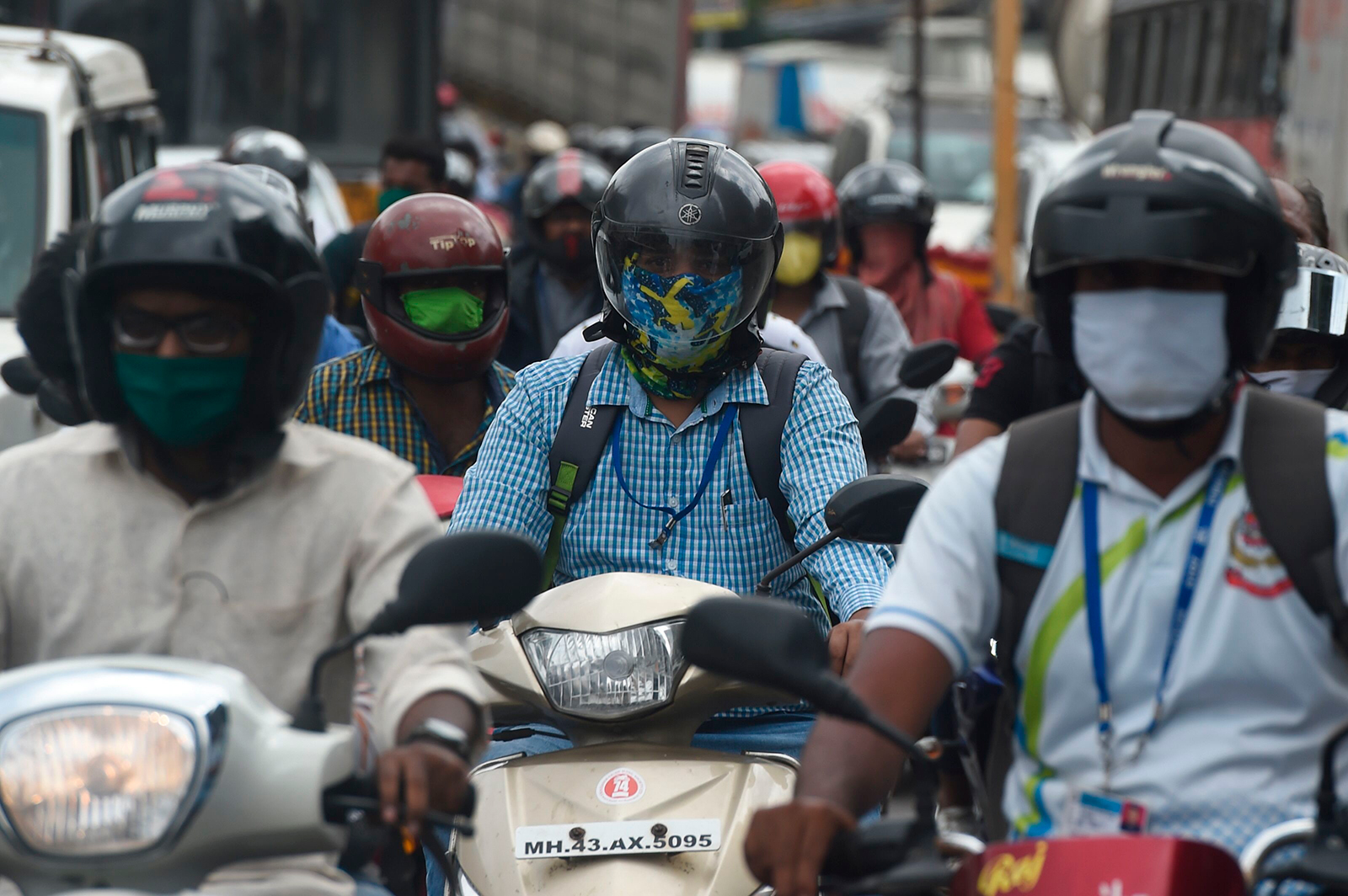
Commuters are seen in a traffic jam during rush hour in Mumbai on June 8. Punit Paranjpe/AFP/Getty Images
The west Indian state of Maharashtra now has a total of 85,975 coronavirus cases, including 3,060 deaths, the country's health ministry announced Monday.
The updated tally means Maharashtra now has more cases than all of China, which has 83,040 cases as of today, according to China’s National Health Commission.
Mumbai, the capital of Maharashtra and home to about 18.3 million people, is the worst hit city nationwide. The city has reported 48,549 cases of coronavirus, including 1,636 deaths.
India's nationwide total stands at 256,611 cases, according to the country’s Ministry of Health and Family Welfare -- of which, approximately a third are in concentrated in Maharashtra state.
Lifting restrictions: India entered the "Unlock 1" reopening phase today, which allows most economic activities to resume.
But Mumbai still has major restrictions in place, effective for schools, train services, cinemas, shopping malls, places of worship, and more spaces.
Only essential workers are allowed to move through Mumbai roads, while travel by rail or air is still prohibited unless specifically allowed by separate orders and standard operating procedures.
From CNN's George Ramsay and Will Ripley
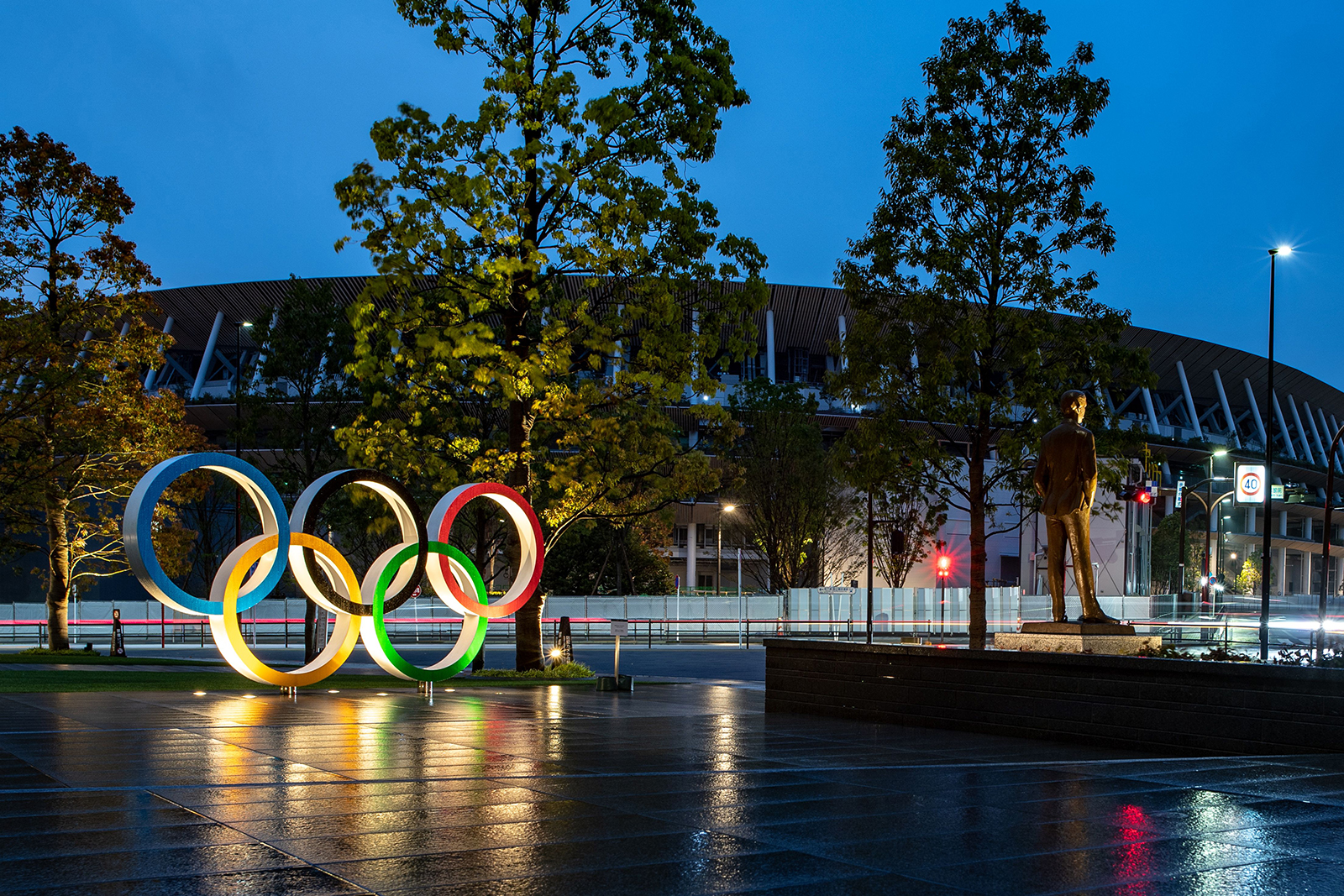
The Olympic Rings are displayed before the National Stadium in Tokyo on April 20. Philip Fong/AFP/Getty Images
The fate of next year's Olympic Games depends on Japan's handling of the coronavirus, according to the Tokyo governor.
Gov. Yuriko Koike said the Games could signify a "victory" over the pandemic, but admitted that more work is still needed to improve treatment and testing, and that organizers were contending with a number of uncertainties.
The Olympics were originally scheduled to begin in July, but the start date has been moved to July 24 next year amid the Covid-19 outbreak.
"The Tokyo 2020 Olympics are an important event that everyone has been waiting for," Koike told CNN's Will Ripley.
"The postponement cost a lot and, more than anything, we do not know what the coronavirus situation will be like in July next year. We have a few uncertainties here ... It costs a lot to begin with, we need understanding from the people of Tokyo for it. We must not spend too much. We have to make the Games safe for athletes and spectators."
Organizers said in December that the cost of hosting the Olympics was some 1.35 trillion yen ($12.35 billion), while sponsors, insurers and broadcasters have also committed billions to the Games.
From CNN's Elizabeth Cohen and Arman Azad
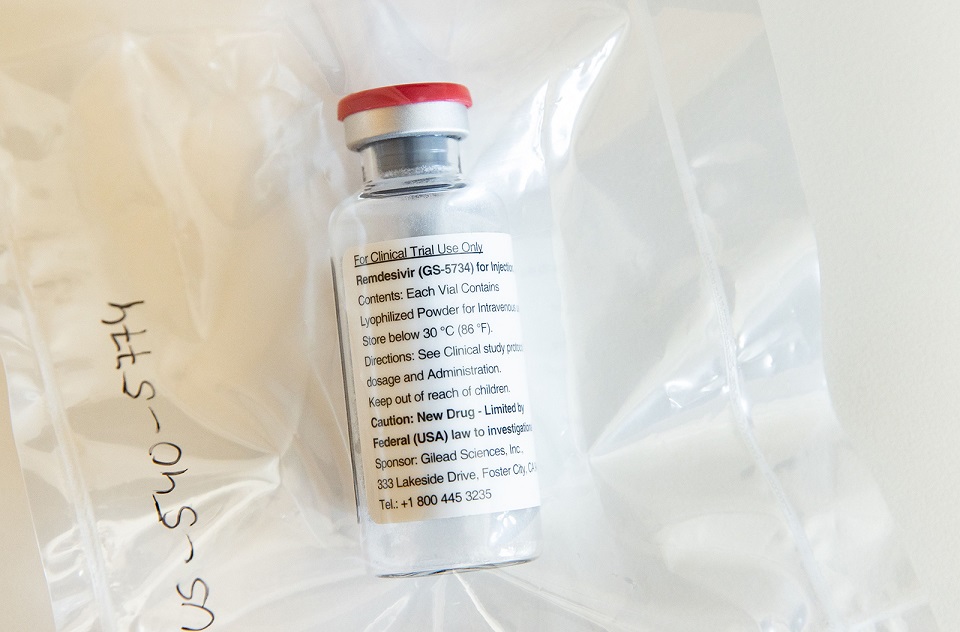
Remdesivir Ulrich Perrey/AFP/Getty Images
The US government's current supply of remdesivir, the only drug known to work against Covid-19, will run out at the end of the month, a federal health official told CNN.
The government's last shipment of the drug will go out the week of June 29. Gilead Sciences, the company that makes the drug, is ramping up to make more, but it's unclear how much will be available this summer.
"Right now, we're waiting to hear from Gilead what is their expected delivery availability of the drug as we go from June to July," said Dr. Robert Kadlec, a US Department of Health and Human Services official.
"We're kind of not in negotiations, but in discussions with Gilead as they project what the availability of their product will be."
Last month, the US Food and Drug Administration gave emergency authorization for remdesivir, an intravenous antiviral medication studied to treat Ebola but now used on hospitalized Covid patients.
While not a blockbuster drug, a study shows it shaves four days off a hospital stay, from 15 to 11 days.
From CNN's Matt Rivers
Coronavirus-related cases and deaths across Latin America are rising faster than anywhere in the world. And in the worst-hit countries, they show no signs of slowing down. The region has recorded nearly 1.2 million cases and more than 60,000 deaths.
"We are especially worried about Central and South America, where many countries are witnessing accelerating epidemics," World Health Organization Director-General Tedros Adhanom Ghebreyesus said on Wednesday.
The WHO does not believe either Central or South America have reached peak transmission, meaning the number of people getting sick and dying might continue to rise.
Brazil is stuck in crisis mode. The country has recorded at least 645,771 coronavirus cases and 35,026 deaths.
It recently passed Italy to become the country with the third-highest deaths in the world and will likely surpass the United Kingdom soon.
Mexico recorded its worst week of the outbreak, both in confirmed cases and deaths.
It recorded more than 1,000 deaths in a single day for the first time. And for three consecutive days, it recorded single-day highs in new cases.
Despite the bleak numbers, and conflicting messages from government leaders, officials have pushed ahead with a phased reopening plan across the country.
Peru has one of Latin America's worst outbreaks. It has 187,400 cases, the second highest in the region behind Brazil.
People in the city of Callao lined up for hours this week to get their oxygen tanks refilled. But once they got to the front of the line, relatives of patients with Covid-19 found skyrocketing prices.
Uruguay is the success story. The country of roughly 3.5 million people borders Brazil, which has the worst outbreak in Latin America.
But Uruguay has recorded just 834 cases. It has recorded one death since May 24 and just 23 fatalities in total.
Experts say the reasons for the country's success are numerous -- a robust early response including quarantine measures, a large and efficient system of tracing and isolating those infected, randomized testing and the creation of a crisis response committee.
Source:https://edition.cnn.com/world/live-news/coronavirus-pandemic-06-08-20-intl/index.html
Here’s a summary of the key coronavirus points so far today.
Infections globally have passed 7 million and deaths have passed 400,000. Covid-19 infections now stand at 7,015,079, after another rise in cases from Brazil. The south American country now has 691,758 cases and 36,455 deaths. The US is the worst-affected country, with 1,940,468 confirmed cases and more than a quarter of the world’s deaths: 110,503. There are 15 countries with more than 100,000 confirmed cases.
New Zealand has declared itself Covid-19-free. The prime minister, Jacinda Ardern, said all coronavirus restrictions, except those at their international border would be lifted at midnight on Monday night. She said she “did a little dance” when she heard there were no cases of coronavirus left in the country. For the past 10 days, a lone woman aged in her 50s, who lived in Auckland, was the last person in New Zealand known to be suffering from Covid-19. On Monday, health officials said, she had reported 48 hours symptom-free and was considered recovered.
UK travel quarantine laws come into force. Most people arriving in Britain from Monday will have to self-isolate for two weeks under a new coronavirus restriction that will apply those coming in by plane, ferry or train. The measures apply to both residents and foreign nationals with some exceptions. Travellers will have to provide details of their journey and the address where they will self-isolate and will face fines of up to £1,000 if they do not follow the rules.
Tokyo’s red-light district workers to be tested for Covid-19. Health authorities are to ask people working in host clubs and similar establishments to be tested regularly for Covid-19 after evidence that the virus is spreading among people who work in the capital’s night-time economy. The city reported 14 new infections on Sunday, six of which involved people working in clubs where employees pour drinks and talk to customers in close proximity.
Vietnam reports two imported cases of Covid-19. Both infections were in Vietnamese citizens returning from Mexico who were quarantined on arrival, its health ministry said.The south-east Asian country has gone 53 days without a domestically transmitted infection and has a total of 331 cases, with no deaths, the ministry said. More than 90% of the confirmed cases have recovered.
Mexico deaths near 14,000. The country’s health ministry reported on Sunday 3,484 new confirmed cases of coronavirus infections and 188 additional fatalities, bringing the total in the country to 117,103 cases and 13,699 deaths. The government has said the real number of infected people is significantly higher than the confirmed cases. The head of Mexico’s Social Security Institute, Zoe Robledo, a close aide to President Andres Manuel Lopez Obrador, said on Sunday he had tested positive for the coronavirus and would continue to work remotely.
Poland reports virus spike linked to mine. Most of the hundreds of new cases reported by the health ministry were linked to a coal mine in the country’s south. The 1,151 new cases – 576 of them registered Saturday and 575 on Sunday – marked the EU country’s highest consecutive two-day total thus far. Nearly two-thirds of those newly infected in Poland, which depends on coal to generate around 80% of its power, are employees of the Zofiowka mine and their family members, according to the health ministry.
Saudi virus cases top 100,000 with new spike ahead of the hajj. The total number of infections rose to 101,914 – the highest in the Gulf – while the death toll climbed to 712, the health ministry said.The kingdom has seen infections spike as it eases stringent lockdown measures, with the number of daily cases exceeding 3,000 for the second day in a row on Sunday. Authorities are yet to announce whether they will proceed with this year’s hajj, scheduled for the end of July, but have urged Muslims to temporarily defer preparations for the annual pilgrimage.